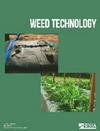评估大麻(Cannabis sativa)对 2,4-D 和麦草畏模拟脱靶事件的无性繁殖和生殖反应
IF 1.3
3区 农林科学
Q3 AGRONOMY
引用次数: 0
摘要
引进对 2,4-D 和麦草畏有抗性的大豆栽培品种,可以在苗后施用这些除草剂。这些除草剂具有很高的脱靶风险,对大麻等作物的潜在影响尚不清楚。从 2020 年到 2022 年,在受控环境中进行了两项研究,以评估大麻对 2,4-D 和麦草畏模拟脱靶率的反应。这项研究的目的是1)确定除草剂(2,4-D 和麦草畏)和剂量(1x 至 1/100,000x 标签剂量)对可见伤害、高度和分枝的影响,以及 2)确定 2,4-D 剂量(1x 至 1/100,000x 标签剂量)对可见伤害、高度、分枝和繁殖参数的影响。除草剂在植物生长初期施用,在处理后 14 天和 28 天以及试验结束时(温室试验在处理后 42 天,生长室试验在收获时)进行评估。在温室试验中,2,4-D 和麦草畏在 1 倍剂量和 1/10 倍剂量下分别造成 68%、78% 和 20% 的伤害。在试验终止 42 天时,使用 1 倍剂量的 2,4-D 和麦草畏或 1/10 倍剂量的麦草畏处理的植株分别比未处理的对照矮 19、25 和 9 厘米。试验结束时,2,4-D 和麦草畏的模拟脱靶率并未影响分枝或植株重量。在生长室研究中,2,4-D 的 1 倍剂量和 1/10 倍剂量在 28 DAT 分别造成 82% 和 2% 的伤害。使用模拟脱靶率 2,4-D 处理的植物的株高、鲜重和大麻二酚 (CBD) 含量与未处理的对照没有差异。这些研究表明,种植大麻二酚的大麻在早期植株生长阶段接触 2,4-D 或麦草畏的脱靶率后,在 42 DAT 或收获时可能不会产生明显的影响。本文章由计算机程序翻译,如有差异,请以英文原文为准。
Evaluating the vegetative and reproductive response of hemp (Cannabis sativa) to simulated off-target events of 2,4-D and dicamba
Introducing soybean cultivars resistant to 2,4-D and dicamba allowed for postemergence applications of these herbicides. These herbicides pose a high risk for off-target movement, and the potential influence on crops such as hemp is unknown. Two studies were conducted from 2020 through 2022 in controlled environments to evaluate hemp response to rates simulating off-target events of 2,4-D and dicamba. The objectives of this study were to: 1) determine the effects of herbicide (2,4-D and dicamba) and rate (1x to 1/100,000x labeled rate) on visible injury, height, and branching, and 2) determine the effect of 2,4-D rate (1x to 1/100,000x labeled rate) on visible injury, height, branching, and reproductive parameters. Herbicides were applied in the early vegetative stage, and evaluations took place 14 and 28 days after treatment (DAT) and at trial termination (42 DAT in the greenhouse trial and at harvest in the growth chamber trial). In the greenhouse trial, 2,4-D and dicamba at the 1x rate and the 1/10x rate caused 68, 78, and 20% injury 28 DAT, respectively. At the time of trial termination 42 DAT, plants treated with 1x rates of 2,4-D and dicamba or 1/10x dicamba were 19, 25, and 9 cm shorter than the nontreated control, respectively. At trial termination, simulated off-target rates of 2,4-D and dicamba did not influence branching or plant weight. In the growth chamber study, the 1x and 1/10x rates of 2,4-D caused 82% and 2% injury 28 DAT, respectively. Plant height, fresh weight, and cannabidiol (CBD) levels of plants treated with simulated off-target rates of 2,4-D were not different from the nontreated control. These studies suggest that hemp grown for CBD exposed to off-target rates of 2,4-D or dicamba in early vegetative stages may not have distinguishable effects 42 DAT or at harvest.
求助全文
通过发布文献求助,成功后即可免费获取论文全文。
去求助
来源期刊

Weed Technology
农林科学-农艺学
CiteScore
2.90
自引率
21.40%
发文量
89
审稿时长
12-24 weeks
期刊介绍:
Weed Technology publishes original research and scholarship in the form of peer-reviewed articles focused on understanding how weeds are managed.
The journal focuses on:
- Applied aspects concerning the management of weeds in agricultural systems
- Herbicides used to manage undesired vegetation, weed biology and control
- Weed/crop management systems
- Reports of new weed problems
-New technologies for weed management and special articles emphasizing technology transfer to improve weed control
-Articles dealing with plant growth regulators and management of undesired plant growth may also be accepted, provided there is clear relevance to weed science technology, e.g., turfgrass or woody plant management along rights-of-way, vegetation management in forest, aquatic, or other non-crop situations.
-Surveys, education, and extension topics related to weeds will also be considered
 求助内容:
求助内容: 应助结果提醒方式:
应助结果提醒方式:


